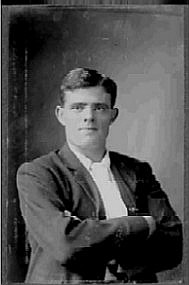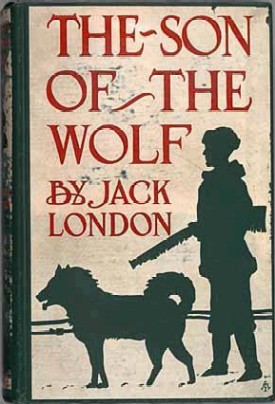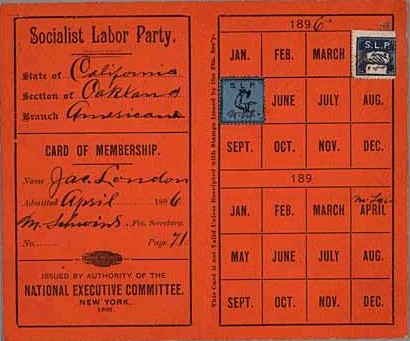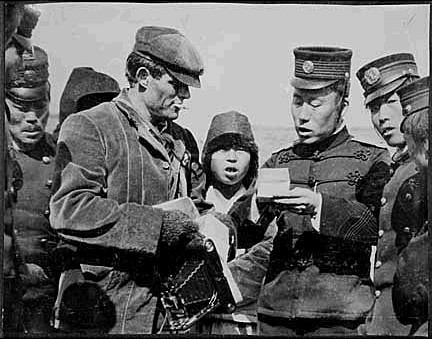본문
http://www.huntington.org/LibraryDiv/JackLondon.html

1876 Born John Griffith Chaney, January 12, in San Francisco to Flora Wellman, common-law wife of William Henry Chaney. She married John London on September 7, and Jack took his surname.
1891 Bought sloop Razzle Dazzle and became an oyster pirate on San Francisco Bay.
1893 Served eight months as a seaman aboard sealing vessel Sophia Sutherland. His "Story of a Typhoon off the Coast of Japan" won first prize in a contest sponsored by the San Francisco Call.
1894 Worked as laborer; tramped "on the road" with Coxey's Industrial Army of the Unemployed and then on his own; served 30-day sentence for vagrancy. His 1907 book, The Road, was based on these experiences.
1895 Attended Oakland High School; his articles and short stories appeared in The High School Aegis.
1896 Joined the Socialist Labor Party.
1897 Left the University of California after one semester. Worked in a laundry before leaving for Alaska in July for the Klondike gold rush. Returned to Oakland in July, 1898.
1898 Submitted "A Thousand Deaths" to The Black Cat magazine, which published the story in May, 1899. The "first money I ever received for a story."
1899 "To the Man on Trail" published in the Overland Monthly.
1900 "An Odyssey of the North" published in the Atlantic Monthly in January. Married Bess Maddern on April 7; Published his first book, The Son of the Wolf.
1901 Daughter Joan born on January 15.
1902 Second daughter Bess born on October 20. Lived for six weeks (August-September) among the poor in the East End of London, England, leading to The People of the Abyss. Published A Daughter of the Snows (his first novel), Children of the Frost and The Cruise of the Dazzler.
1903 Published The Call of the Wild, The Kempton-Wace Letters (written with Anna Strunsky), and The People of the Abyss.
1904 War correspondent for Russo-Japanese War. Bess Maddern London filed for divorce. Published The Sea Wolf and The Faith of Men.
1905 Purchased his first 129 of the eventual 1400 acres of the Beauty Ranch in Glen Ellen in the Sonoma Valley. Married Charmian Kittredge. Published War of the Classes, The Game, and Tales of the Fish Patrol.
1906 Began building schooner Snark for projected seven-year, round-the-world voyage. Reported San Francisco earthquake. Published Moon-Face and Other Stories, White Fang, and Scorn of Women.
1907 Snark, with Jack, Charmian and crew, sailed to Hawaii, Marquesas Islands, and Tahiti. Published Before Adam, Love of Life and Other Stories, and The Road.
1908 Snark continued to Samoa, Fiji Islands, New Hebrides, Solomon Islands, and Australia, where Jack and Charmian were hospitalized and forced to abandon cruise. Published The Iron Heel.
1909 Returned to Glen Ellen. Published Martin Eden.
1910 Step-sister Eliza London Shepard became ranch superintendent. Daughter Joy born on June 19, died on June 21. Published Lost Face, Revolution and Other Essays, Burning Daylight, and Theft: A Play in Four Acts.
1911 Spent summer driving wagon and four horses to Oregon and back, with Charmian and valet Yoshimatsu Nakata. Published When God Laughs and Other Stories, Adventure, The Cruise of the Snark, and South Sea Tales.
1912 With Charmian, sailed aboard the Dirigo from Baltimore to Seattle around Cape Horn. Published The House of Pride and Other Tales of Hawaii, A Son of the Sun, and Smoke Bellew.
1913 Wolf House destroyed by fire. Attended San Francisco premier of The Sea Wolf, the first feature-length film produced in the U.S. Published The Night Born, The Abysmal Brute, John Barleycorn, and The Valley of the Moon.
1914 Went to Vera Cruz to report on the Mexican Revolution, then left for Hawaii after returning to Glen Ellen for health. Published The Strength of the Strong and The Mutiny of the Elsinore.
1915 Sailed to Hawaii in February and again in December. Published The Scarlet Plague and The Star Rover.
1916 Resigned from the Socialist Party. Returned from Hawaii in July. Died at the Beauty Ranch on November 22. Published The Acorn-Planter: A California Forest Play, The Little Lady of the Big House, and The Turtles of Tasman.

처음으로 출간한 책, <늑대의 자식>, 1900
This volume is Jack London's first published book. London became a professional writer in 1899 with the publication of such short stories as "A Thousand Deaths," "To the Man on Trail," and "White Silence."
Almost overnight, London had begun to achieve fame (he was sometimes called the "Kipling of the Klondike"), and in 1900 Houghton, Mifflin and Company offered to publish London's Alaskan tales in book form, to be called The Son of the Wolf.

사회주의자 노동자 당원이었던 잭 런던의 당원증.
잭 런던은 1896년 오클랜드에서 가입해 '소년 사회주의자'가 됐다.
Jack London's membership card in the Socialist Labor Party, Oakland, April, 1896.
As a tramp on the road, and laboring at spirit-deadening jobs in canneries and factories for starvation wages, the young Jack London deplored the subjugation of the working class by the wealthy. He joined the party in Oakland in 1896, became known as the "boy socialist" for his lecturing, and even ran for mayor twice for the Social Democratic Party.
Despite his own individualism and financial success, London remained a vocal socialist throughout his life. However, he resigned from the party shortly before his death, because he felt it had lost its fire and would not take the risks necessary to achieve victory in the class struggle.

Jack London. "A Camera and a Journey," in In Many Wars, Tokyo, Tokyo Printing Company, 1904.
In 1904, London covered the Russo-Japanese War as a correspondent for the Hearst newspaper syndicate. Not content to wait in Japan with other correspondents for permission to travel to the front in Korea, London set out on his own by rickshaw and train. He got as far as Moji, where taking some innocent photographs landed him in jail with his camera confiscated. Moji was a naval base, and it took the intervention of fellow correspondent Richard Harding Davis to free London and his camera. London pressed on to Korea, via junk and sampan.
London had become famous with the publication of The Call of the Wild in 1903, and his own escapades at the front made even better news than the war stories he filed. His camera essay first appeared in the San Francisco Examiner on February 3, 1904, with the headline, "How Jack London got in and out of jail in Japan." In Many Wars is a compilation of war essays by the correspondents.





최근 댓글 목록